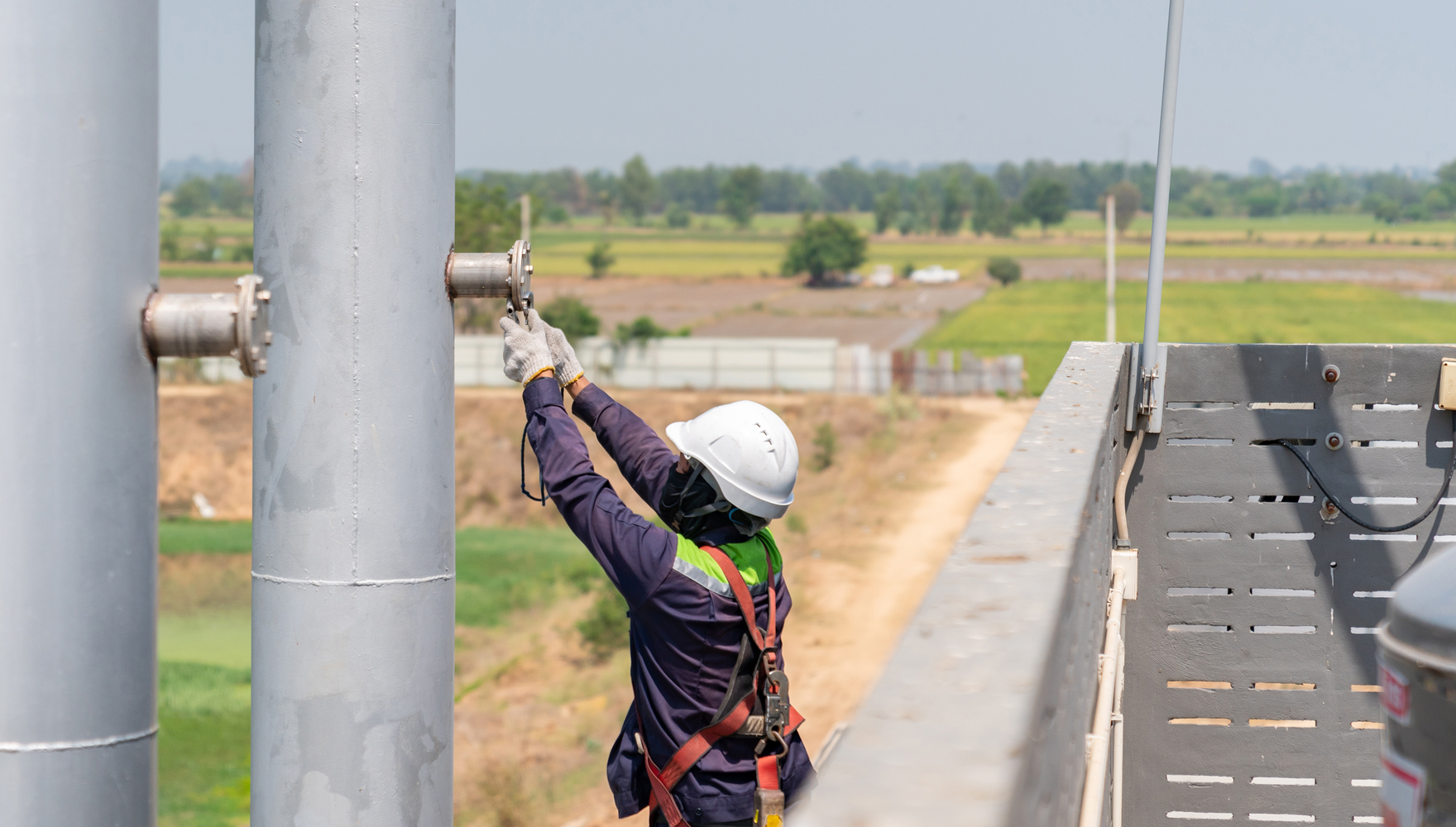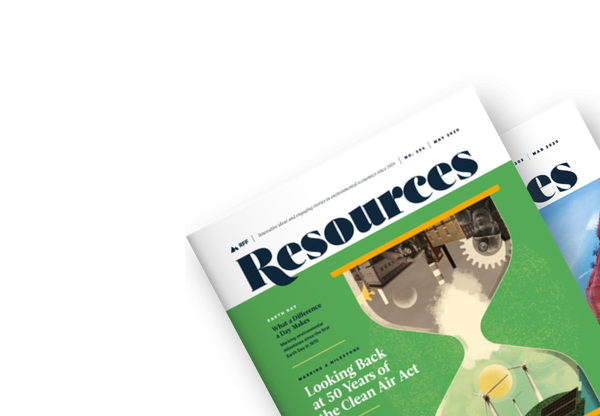In this week’s episode, host Daniel Raimi talks with Neha Khanna and Ruohao Zhang about how government shutdowns prevent active air-pollution monitoring—and end up leading to more air pollution from coal-fired power plants while monitoring is on hiatus. Professor Khanna from Binghamton University and Assistant Professor Zhang from Pennsylvania State University published a related study, with another coauthor, examining the impact of the 2018–2019 government shutdown on pollution emissions from federally regulated coal-fired power plants. The authors found that the hiatus on pollution monitoring by federal employees, who were furloughed during the shutdown, led to an increase in the types of pollutants that required manual regulation at power plants. In this podcast episode, Khanna and Zhang reflect on how these findings may likewise inform how pollution rates may have changed during the government shutdown that ended just last week.
Listen to the Podcast
Audio edited by Rosario Añon Suarez
Notable quotes:
- Particulate matter requires manual monitoring, unlike other pollutants—so, particulate matter is more susceptible to changing inspection patterns: “We got a really nice natural experiment where one gas (particulate matter) was not being monitored, as it was under non-shutdown (or normal) government operations, whereas for the other two gases, there was no impact on the way that they were monitored. So, we could tell if just the disruption of monitoring would lead to a different behavior by the power plants.” —Neha Khanna (6:44)
- Air pollution from coal-fired power plants increased during the 2018–2019 government shutdown: “In this paper, we find that the particulate matter pollution around the coal power plants spiked as soon as the EPA [US Environmental Protection Agency] furlough began … We find that the aerosols near those power plants were about 15 percent to 20 percent higher than usual. Once EPA inspectors returned to work, we also noticed that particulate-matter pollution quickly dropped back down to a normal level.” —Ruohao Zhang (8:20)
- Power plants shown to increase their pollution when not regulated: “Power plants typically control their particulate matter emissions using a device called the electrostatic precipitator, which removes the particles from exhaust emissions before they exit the smokestack … During the regulations’ disappearance, plants may have some incentive to save costs by temporarily turning off these pollution-control devices or reducing the operation of these devices.” —Ruohao Zhang (12:35)
- Pollution likewise could have gone up during the most recent government shutdown: “I would expect that if the incentive structures that we found to exist in the 2018–2019 shutdown are similar, we would expect similar behavior from plants. If pollution control is expensive, and the operating units are fairly confident that monitoring is not as stringent as it has been, then they would have an incentive to increase their emissions. But I need to emphasize that we haven’t directly studied this, so this is a suspicion—not an analysis of data.” —Neha Khanna (15:36)
Top of the Stack
- “Monitoring and Enforcement and Environmental Compliance: Power Plant Emissions During the 2018–19 Federal Government Shutdown” by Ruohao Zhang, Huan Li, and Neha Khanna
- “Coal plants emitted more pollution during the last government shutdown, while regulators were furloughed” by Ruohao Zhang, Huan Li, and Neha Khanna
- The Conversation online platform
- The Lorax by Dr. Seuss
The Full Transcript
Daniel Raimi: Hello, and welcome to Resources Radio, a weekly podcast from Resources for the Future (RFF). I’m your host, Daniel Raimi. Today, we talk to Professor Neha Khanna from the State University of New York at Binghamton, and Ruohao Zhang, assistant professor at Penn State University.
Along with their coauthor Huan Li, Neha and Ruohao recently published a study about what happens to pollution when the federal government shuts down. Specifically, they looked at how federally regulated pollution from coal-fired power plants changed when federal oversight declined as a result of the shutdown in 2018–2019. Could the same thing be happening during this year’s shutdown? It’s hard to think of a more timely topic, so stay with us.
Neha Khanna, welcome back to the show, and Ruohao Zhang, welcome to Resources Radio; it’s great to have both of you.
Neha Khanna: It’s great to be back.
Ruohao Zhang: Thank you, I’m excited about this.
Daniel Raimi: We’re excited to have you. Ruohao, Neha has been on the show before, so I’d love to ask just you this question to get started (which is the same question we ask everybody when they come on the show for the first time): which is how you got interested in working on environmental issues.
Ruohao Zhang: I remember that there was a time during my childhood when environmental pollution was a quite serious issue in my hometown, and that’s mainly due to the rapid economic growth and the industrial expansion and development. But a couple of years after, it feels as if, all of a sudden, the environment has begun to improve significantly.
I wasn’t sure (back to that time) what was happening, but later, when I began on my graduate studies, I started to wonder: What had caused those changes? How did they happen? Why the economy was still growing so fast?
So, that’s why I started studying something related to environmental policies, and how to balance economic development and environmental protection.
Daniel Raimi: That totally makes sense. And where did you grow up?
Ruohao Zhang: Hangzhou, China—it’s in the eastern part.
Daniel Raimi: Great, really interesting. Well, the two of you, along with a third coauthor Huan Li, recently published a study in the Journal of the Association of Environmental and Resource Economists looking at this issue of coal-fired power plant emissions during the 2018–2019 government shutdown. We are recording this during another government shutdown—we’re recording on November 5, 2025. So, listeners, when you listen to this, it may or may not still be a government shutdown. But, I’m curious to hear from you: How did you get the idea to study this issue in the first place?
Neha Khanna: Well, during the previous shutdown in 2018–2019, I remember I read a newspaper article that mentioned that the inspectors from the US Environmental Protection Agency (EPA) were among the federal employees who were furloughed. And somehow that made the shutdown a little more real and personal to me, and it immediately made me wonder how this would impact the enforcement of federal environmental regulations.
Normally, as economists, I like to joke that we are a year or two out of date, because we have to wait for data to be available; by the time we get to analyze it, the world has moved on. In this particular instance, Ruohao (my coauthor on that paper) had just learned how to use satellite data that is provided by NASA satellites—in particular, data on aerosol optical depth, or AOD, which correlates really well with airborne particulate matter. This data, in fact, is available on a daily basis, and with one- or two- to three-week lag. Over and above that, it’s available in a very fine geographic scale—unlike typical data that we use, which is on a census tract, census block group, or something like that.
At the same time, we were also aware that the EPA monitors other gases continuously—these are nitrogen oxides, or what we call NOx, and sulfur oxides, which we call SOx—especially from coal-fired power plants, because these gases are traded on a permit market.
We decided that we could actually study short-term changes in the concentrations of these gases, or remissions of these gases, that is particulate matter (which we would proxy through aerosol optical depth), NOx, and SOx. These were about as close to real-time data that we could get, and I think, for once in my life, I felt really relevant—it was a very exciting moment.
Daniel Raimi: That is cool. Well, as you’ve alluded to just now, there are different types of pollutants that might come out of a coal-fired power-plant stack, and those pollutants are actually monitored and measured in different ways. Can you give us a quick overview of how these different types of air pollution are monitored, and why that matters for the story that we’re going to tell today?
Neha Khanna: Sure. Power plants, especially coal-fired power plants—that’s what we focused on because their primary fuel is coal, which is very polluting—produce a lot of different airborne pollutants. The ones that we focused on were three: nitrogen oxides, sulfur oxides, and particulate matter. The reason we focus on three—well, one is the easy answer, which is the data are available—they’re rich, easy to access, and very detailed. So, from an empirical perspective, that just is perfect.
But, more importantly, they can be divided into two distinct groups. Nitrogen oxides and sulfur oxides are monitored through the EPA’s Continuous Emission Monitoring Program, or CEMS, and they’re continuously monitored on a 24/7 basis. Under this program, there are small sensors that are placed at power plants—in fact, at individual generating units at the power plants. These automatically transmit emissions data to the EPA, and this transmission was not disrupted by the furlough of federal employees.
Particulate matter is different, because its concentrations attract not at individual plants, but at pollution monitors—roughly about 1,000 to 1,200 that are spread across the country. These monitors require manual collection of samples, and this manual collection was affected by the furlough.
At the same time, the EPA also conducts on-site inspections to track these emissions of particulates. Again, these on-site inspections, by inspectors who carry federal employee identity cards, were also disrupted during the shutdown. We basically got a really nice natural experiment where one gas (particulate matter) is not being monitored, as it was under non-shutdown (or normal) government operations. Whereas for the other two gases, there was no impact on the way that they were monitored. So, we could tell if just the disruption of monitoring would lead to a different behavior by the power plants.
Daniel Raimi: That’s so interesting. And it makes me think of a quick follow-up question (which, maybe we don’t have time to go down this rabbit hole) but, Why is it that particulate-matter monitors require manual intervention, whereas these other monitors don’t? I have a PurpleAir monitor outside my house, and that is continuously measuring. Are the sensors for particulate matter different in some substantial way that really matters and requires this type of human intervention?
Neha Khanna: I’m now stepping outside of my area of expertise, so I’m sure someone else is going to have a better answer out there. My understanding is that for particulate matter, first of all, we are not measuring their emissions (the very fine particulates), we’re measuring their concentrations. That’s why they’re measured at these monitors, and they literally have the equivalent of a filter paper that has to be removed. Why that technology still persists, and why we cannot monitor it directly, I don’t know. That is really a question for somebody who’s more on the engineering side.
Daniel Raimi: Great. We’ll do another podcast on pollution-monitoring devices, and why we’re still using pieces of paper.
I’d love to ask you now just to dive into the results. What did you find when the government shut down? How did that affect these rates of pollution?
Ruohao Zhang: In this paper, we find that the particulate-matter pollution around the coal power plants spiked as soon as the EPA furlough began. So, as Neha mentioned, the way that we measure particulate matter is using these NASA remote sensing data that tracks the aerosol levels as a proxy for particulate matter. We find that the aerosols near those power plants were about 15 percent to 20 percent higher than usual. Once EPA inspectors returned to work, we also noticed that particulate-matter pollution quickly dropped back down to a normal level.
It’s also interesting to find that sulfur dioxide and the nitrogen oxides did not increase during the EPA furlough. We think it is likely because these emissions are always being recorded by the sensors inside of the smokestacks. So, during the shutdown, the monitoring continued and did not interrupt it. But the particulate matter is not monitored continuously, and it mostly relies on, as Neha mentioned, the manual sampling and on-site inspections—which are all stopped during the shutdown. I think the pattern is quite clear here: When the EPA stopped watching, plants increased pollution that was not being monitored. Once inspection resumed, the emissions returned to normal.
Daniel Raimi: Really interesting, and pretty intuitive from a rational economic perspective. One of the other key results that you discuss in the paper is the difference between counties that were in attainment with EPA’s National Ambient Air Quality Standards, and those that were not in attainment with those standards. Can you talk about that result?
Ruohao Zhang: Yeah. We find the temporal increase in emissions was actually greater for plants located in attainment counties (which generally meets furlough standards), but the plants in the nonattainment county did not really show much change during the shutdown. Our explanation is, because the local regulation doesn’t matter very much in whole regulation policies, nonattainment counties often have stricter state and local rules designed to clean up the air problems and avoid additional federal penalties of being listed as nonattainment counties in the future. Even with federal oversight passed during the shutdown, plants in those areas may still be under relatively stricter local regulations—so, they possibly still maintained better environmental compliance compared to their peers in attainment counties.
Daniel Raimi: That’s really interesting. Can you give an example, or two, of what those local or state standards or regulations might look like? Were there people monitoring those coal plants at the state level, or at the local level, for particulate matter, or were there other technology controls that might have been in place? Can you just talk about some of the causal effects there?
Ruohao Zhang: The inspections are not just coming from the federal EPA, it also comes from the local and the state environmental department. Once a county is listed as a nonattainment county, then the federal government will require the county to come up with a plan to clean up their air pollution; otherwise, it will face some additional penalties. During the federal shutdown, it will not affect the state-level and the local-level inspections—they still carry on inspections. So, these local inspections also play an important role in regulation.
Daniel Raimi: That makes sense. What are some of the actions that you think power-plant owners took that actually led to this increase in particulate matter? Did they start using a different kind of fuel? Did they turn off certain pollution controls? What do you think they physically did?
Ruohao Zhang: We suspect that the actions they did could be related to the use of pollution-control technologies. Power plants typically control their particulate-matter emissions using a device called the electrostatic precipitator, which removes the particles from exhaust emissions before they exit the smokestack; operating these devices also requires both money and energy.
During the regulations’ disappearance, plants may have some incentive to save costs by temporarily turning off these pollution-control devices or reducing the operation of these devices. There are also other actions power plants may take—such as shifting to a cheaper, but a lower grade of, coal, or running a less efficient generation unit. However, we tested the data, and we did not see any evidence supporting these alternative actions.
Daniel Raimi: That’s really interesting. I’m curious, from the fuel-source perspective, whether it actually even would be easy for a coal plant to switch between fuels—because, oftentimes, fuels are procured over long terms, with long, fixed contracts. To be honest, I don’t even know how different the pollution effects would be from different types of coal, but I’m curious if either of you had dug into that in any more detail.
Neha Khanna: We did discuss that possibility in our data—we examined it, I should say. Because, even though you’re right that there are long-term contracts with suppliers, a supplier can have many grades of coal available. You could have grades which have high BTUs [British Thermal Units], but higher sulfur, or just different chemical properties that would affect the way it combusts and how it oxidizes to produce sulfur dioxide, nitrogen oxides, or particulate matter. We did actually allow for that possibility, and we ran empirical tests to see if we found any evidence of using a different grade of coal; we did not find that.
Daniel Raimi: Interesting. Also, the 2018–2019 shutdown, Was that,35 days, roughly?
Neha Khanna: Correct.
Daniel Raimi: And coal-plant owners typically have a big pile of coal sitting around on hand, so they might not even had time to procure new sources given that relatively short duration.
As I mentioned earlier, we are recording this episode during another government shutdown and at a time when the federal administration is a big booster of coal—they want more coal production, more coal-fired power generation across the United States. Do you suspect that the same type of turning off of pollution controls are happening right now and having consequential effects on air quality?
Neha Khanna: Well, to be clear, we haven’t studied the effects of the current shutdown. Anything I say is really under the guise of suspicion, rather than any real analysis. But, I would expect that if the incentive structures that we found to exist in the 2018–2019 shutdown—if there are any similar to that today, we would expect similar behavior from plants. If pollution control is expensive, and the operating units are fairly confident that monitoring is not as stringent as it has been, then they would have an incentive to increase their emissions. But, again, I need to emphasize that we haven’t directly studied this; this is a suspicion, not an analysis of data.
Daniel Raimi: Right. One thing that I would love to dig into a little bit more is this question of whether things have changed since the 2018–2019 shutdown. I’m curious, to the best of your knowledge, Are the types of EPA workers who were furloughed in 2018–2019 also being furloughed today?
Neha Khanna: I don’t know because, right now, I have not dug into the EPA’s plans and who exactly was furloughed. I don’t know. Ruohao, do you have any information on this?
Ruohao Zhang: No, I didn’t pay attention to the news about this shutdown.
Neha Khanna: It seems like this time, there isn’t—at least in the public general media. I’m hearing a lot more about other sectors of the economy, like traffic control, immigration, and so on, where we’re getting news reports of furloughs. I have not heard of anything on the EPA side, and so we haven’t really furloughed much.
Daniel Raimi: Right, interesting. It’s also possible after the last year that many of the inspectors have either been let go as a result of the DOGE [US Department of Government Efficiency] effort, or lots of people have left the federal government for other reasons. I wonder if there’s a short-staffing in place, even before any potential furloughs might be happening.
Neha Khanna: That would be a question for another study to see, if—ever since we had DOGE, once we get real information on who has been let go, or who has voluntarily let themselves go—if we can find any evidence of increased emissions because of that; but that would be a different paper.
Daniel Raimi: Okay. Well, we’ve got ideas for multiple papers going on!
I think another thing that I’m wondering about is other types of governmental enforcement. I’m sure there are other things that the government monitors that require some type of human intervention that could be affected by government shutdowns, furloughs, layoffs, and all that stuff. I’m curious if there are other examples that either of you can point to, where a government shutdown in particular might lead to nonenforcement or nonmonitoring of other risks to air quality, water quality, and human health?
Neha Khanna: Well—again, we haven’t directly studied this—it is possible, during a government shutdown, that there are other environmental hazards that are not being monitored, or even being monitored less. The third coauthor on this paper, Huan Li, and I did a study many years ago on how, under a budget constraint, an EPA regulator shifts resources from one sector to another sector simply based on where it’s better spent. So, it is possible that this is going on—but, again, I haven’t studied this directly. Maybe Ruohao has something to say on this.
Ruohao Zhang: I also don’t have any ongoing research on this, but I think it’s a very interesting question to study. I’ve been thinking about the weather—it could be more likely to have some environmental-related accidents during the shutdown due to the short staff, or less federal oversight. That is a possibility, but we haven’t done anything on that yet.
For example, there was a major oil-refinery explosion in California recently during this government shutdown, but it is not clear (it’s hard to see) if the shutdown played any role in that. I think there might be a challenge in doing such a study, because usually a shutdown doesn’t last too long, so there might not be enough data to see a clear pattern in such a rare event like the environmental-related accidents—but it’s worth exploring a little bit.
Daniel Raimi: Maybe if there’s one silver lining to the longest federal shutdown in US government history, it is that we’ll have more data to study and try to see if we can tease out any causal effects of the shutdown on these types of pollution events.
Well, Neha and Ruohao, thank you so much for all this information. It’s really fascinating, and we’re generating lots of new ideas, which I also appreciate. I’d love to ask you both now to share something with our audience that you think is really great; it could be related to the environment either loosely or very closely. We’re just curious if you can share something that you’ve read, watched, or heard that’s at the top of your literal or your metaphorical reading stack.
Neha Khanna: Well, let me start that. Especially during the government shutdown—where I feel like every day you don’t know whether it’s going to be another day in the shutdown, whether it’s going to end, or how the shutdown is going to affect different parts of our daily lives—I’ve been reading the newspaper a lot. I know that sounds very old-fashioned and almost boring, but it is really my source for all kinds of not just information, but also ideas for papers (just like this paper came out of reading a newspaper article). Honestly, that’s the stuff I’ve been focusing on a lot—whether it’s the print media or virtually, places like Politico, and especially focusing on energy and environment news, because that’s directly related to what I do. That’s what I’ve been doing a lot of every day, taking time out to read the newspapers.
Daniel Raimi: I would just second that point on Politico and E&E News, in particular. It’s like an essential morning read, at least for me, the multiple publications that they have coming out. Ruohao, how about you? What’s at the top of your stack?
Ruohao Zhang: I just mostly read articles published on these well-known news sites related to environmental and policy-related topics. And my brother actually already learned what I would like to stop and read, so every time I open it, it will pop up some top environmental and policy leader stories right on the homepage. So, I don’t pay attention to what the source is, I just click whatever seems interesting.
I want to add another good website—there is a website called The Conversation that we recently worked with to publish some articles. That is a platform that works very closely with researchers to turn academic studies into easy-to-read articles for the general public. We also did an article with them related to this particular study about the government shutdown and the environmental consequences. So, that could be a good source to learn and connect to the frontier of environmental research.
Daniel Raimi: Totally, The Conversation is great.
Neha Khanna: Daniel, can I add something a little bit lighter, but true, on just this?
Daniel Raimi: Please.
Neha Khanna: It’s not something I read or do on a regular basis, but one of my favorite things to go back to is Dr. Seuss’s The Lorax. Believe it or not, I actually have a stuffed Lorax that I keep with me at all times.
Daniel Raimi: Nice.
Neha Khanna: It’s just something as simple as that, that is meant for children, but has such a long-lasting impact and meaning. At times like this, sometimes when I feel a little despaired (or just wonder, after a long career, what difference did I make), I go back to The Lorax because it still inspires me.
Daniel Raimi: That’s great. I’m curious about your Lorax that you keep with you at all times. Is it small? Does it live in your purse? Where is it?
Neha Khanna: I say “at all times.” No, it’s a little stuffed toy, maybe about 10 inches tall and six to eight inches wide. It’s got the arms, legs, and the little jelly-bean shape; it has a giant mustache. I actually keep it with me in my office at home. I’ve thought about taking it to class many times; I’ve not had the courage to do that because I think the students would think I’ve completely lost my mind. But it’s there, and I look at it every day.
Daniel Raimi: That is great. Well, I think that’s a really nice note to end on. And, I’ll just say one more time, Neha Khanna from SUNY Binghamton and Ruohao Zhang from Penn State, thank you so much for coming on the show and sharing this fascinating research.
Neha Khanna: Thank you, Daniel. And thank you for the work that you and RFF are doing in this context, as well.
Ruohao Zhang: Thank you so much; this was a very good experience.
Daniel Raimi: You’ve been listening to Resources Radio, a podcast from Resources for the Future, or RFF. If you have a minute, we’d really appreciate you leaving us a rating or a comment on your podcast platform of choice. Also, feel free to send us your suggestions for future episodes.
This podcast is made possible with the generous financial support of our listeners. You can help us continue producing these kinds of discussions on the topics that you care about by making a donation to Resources for the Future online at rff.org/donate.
RFF is an independent, nonprofit research institution in Washington, DC. Our mission is to improve environmental, energy, and natural resource decisions through impartial economic research and policy engagement. The views expressed on this podcast are solely those of the podcast guests and may differ from those of RFF experts, its officers, or its directors. RFF does not take positions on specific legislative proposals.
Resources Radio is produced by Elizabeth Wason with music by me, Daniel Raimi. Join us next week for another episode.











